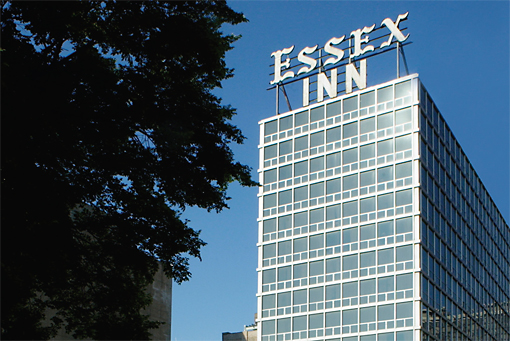| 제목 | [DAIKIN] HOSPITALITY - The Essex Inn Hotel | 작성일 | 16-06-16 13:27 |
| 글쓴이 | 최고관리자 | 조회수 | 2,989 |
본문
CASE STUDY
Hospitality
Name
The Essex Inn
Location
Chicago, IL USA
Facility Size
14-story, 254-room hotel
Issue
Improve system efficiency and reduce the hotel's operating costs
Solution
(2) Daikin 300-ton dual compressor centrifugal chillers
Daikin Dual Compressor Chillers Deliver 26% Electrical Cost Savings
for Chicago Hotel
The Essex Inn, overlooking Grant Park, is a short walk from Chicago's world-famous museums and other downtown attractions. Such a central location draws guests year-round to shops, museums, concerts, sports, and other events. There is no off-season for the Essex Inn, and that's why the hotel puts a premium on an HVAC system that operates reliably and efficiently. The hotel had been well-served by two Daikin/ Westinghouse dual compressor centrifugal chillers since 1972, but today's electrical costs required they be replaced to improve efficiency and reduce the hotel's operating costs.
And even though the chillers were still going strong, hotel officials were reluctant to gamble on reliability for much longer. "For the hotel business, HVAC system reliability is vitally important," said Steve Tischler, the hotel's chief engineer. "Otherwise, you won't have any guests. If they walk in and the air conditioning isn't working, they'll walk right back out."
With two new Daikin 300-ton dual compressor centrifugal chillers installed this spring, guests continued to be comfortable all summer long, even in Chicago's record-setting heat and humidity. Hotel management saw immediate results, too. During June, the first month of operation, the chillers saved $11,000 in electrical costs—that's an actual savings of 26 percent and 47 percent savings over budget.
Two compressors do the work of four
The Essex Inn, built in 1961, is a 14-story, 254-room hotel, which also includes five banquet rooms a restaurant and an enclosed pool and fitness center. In a move to reduce heating and cooling costs, Tischler had all of the single-paned windows upgraded three years ago. "The idea worked, to a point, but the hotel's manager wanted more," said Tischler. "It wasn't news to us that we needed to replace our HVAC equipment. But when Daikin's EnergyAnalyzer® design tools program showed us that the project would pay for itself after just 10 years, we knew we could no longer afford the risk of the chillers breaking down during the heat of the summer, not to mention the cost of the electricity."
Tischler also wanted to move away from the old chiller's R-12 refrigerant, which is phased out according to the Montreal Protocol. The new chillers use R-134a refrigerant, which has no phase-out date and, according to Tischler, is cheaper than R-12.
So far, the centrifugal chillers are the only upgrade to the hotel's centralized HVAC system, although future plans call for a new air handler and new fan coil units in the guest rooms. Still, the new chillers make all the difference, according to Tischler. "Once I turn (the chillers) on, it's noticeable within 30 minutes; you feel it everywhere," he said. "But there's still the same amount of water to cool. The real advantage is that at most two compressors, rather than four, can handle the job." (See below on dual compressor centrifugal chillers.)
The old chillers required all four compressors and 570 amps of electricity at start-up. The new chillers typically run on two of the four compressors, and at times just one compressor holds the load for the entire building.
Even during the hottest days of the summer, two compressors would pull about 38 percent of their load – about 41 amps – and cool water to 45 degrees to keep the building's temperature constant. "The hot days started in June and didn't stop until September," said Tischler. "I was there every day, and no matter what the outside temperature, the chillers always ran at 38 percent."
Efficiency due to advanced design, controls, careful match to load requirements
Prior to the chiller upgrade, the electrical bill for the entire hotel was about $150,000 every six months. After the first cooling season of operation, Tischler says he expects his energy cost savings to be about 40 to 50 percent. He attributes the impressive results to several factors. First, the new dual centrifugal chiller design is far more advanced than the design of 30 years ago. Second, the chillers are fitted with Daikin MicroTech II® controls, allowing Tischler to regulate just about any variable via a user-friendly touch screen panel. Because the hotel does not have a building automation system, the entire chiller plant runs off the digital controls.
Thirdly, the chiller is designed to match the building's load requirements. "We were careful not to under-design or over-design for the load conditions," said Tischler. "Centrifugal chillers like to run with a constant load. If they turn on and off frequently, or run at a range of loads, it increases energy costs and wear and tear on the machine."
A new, quieter mechanical room
Surprised as he was by the cost savings the chillers deliver, Tischler is particularly impressed by their quiet operation. "You can barely hear them running," he said. "Now we can talk in the mechanical room. Before, we needed earplugs."
The mechanical room also looks different than it did before the new chillers were installed. In 1972, the old chillers were "kind of shoehorned into place," said Tischler. Today's building codes required a better fit. Knocking out two walls added space and even allowed room to put the starters on their own stands in a separate area. And Daikin factory engineers helped, too. Changing the vessel design of each chiller slightly— shorter length, bigger circumference—gave the extra three feet of space needed to fit both chillers into the room.
\ Even though Tischler knew from the Daikin EnergyAnalyzer program that he could expect significant energy savings, he's still impressed by the reality. "I was pleasantly surprised by the amount of savings," he said. With its renewed HVAC system delivering the reliability and efficiency Tischler required, the Essex Inn continues to be well situated as a destination of choice in downtown Chicago.
Daikin Applied delivers engineered, flexible solutions for commercial, industrial and institutional HVAC requirements with reliable products, knowledgeable applications expertise and responsive support. Daikin products and services are provided through a worldwide network of dedicated sales and service offices. For more information or the name of your local Daikin representative, call 1-800-432-1342 or visit www. DaikinApplied.com.
Dual compressor chiller delivers significant part-load efficiency
The major benefits of a dual centrifugal chiller are its part load efficiency and its ability to unload smoothly to match the exact building load—down to five percent of the full load capacity without an inefficient hot gas bypass system. While single compressor chillers are most efficient at or near 100 percent capacity, and often require hot gas bypass to unload, a dual compressor chiller is most efficient at 50 to 60 percent capacity and can easily unload much further. This matches the typical building load profile very well, offering optimum efficiency where there are the most run hours. Dual compressors can provide a 20 percent increase in energy savings compared to single compressor chillers. The dual centrifugal chillers utilize two compressors on a common refrigeration circuit— evaporator and condenser—which is the reason for the part load efficiency gain. A half-size compressor is operating on a full-size set of shells. Each of the 300-ton chillers at the Essex Inn has two nominal 150-ton compressors mounted. As the chiller unloads from 100 percent load, one compressor shuts off at about 90 tons (60 percent of full load). Only one compressor is required to circulate enough refrigerant to meet the load. That compressor is operating with its inlet guide vanes wide open and at maximum compressor efficiency. Additionally, the compressor is operating with a condenser and evaporator designed for twice the capacity. In effect, the two heat exchangers have twice the required surface area. This lowers the lift and improves the compressor performance.
| 이전글 | [DAIKIN] HOSPITALITY - Hotel Nikko 2016-06-16 | ||
| 다음글 | [DAIKIN] K-12 EDUCATION - Achilles Elementary School 2016-06-16 | ||






